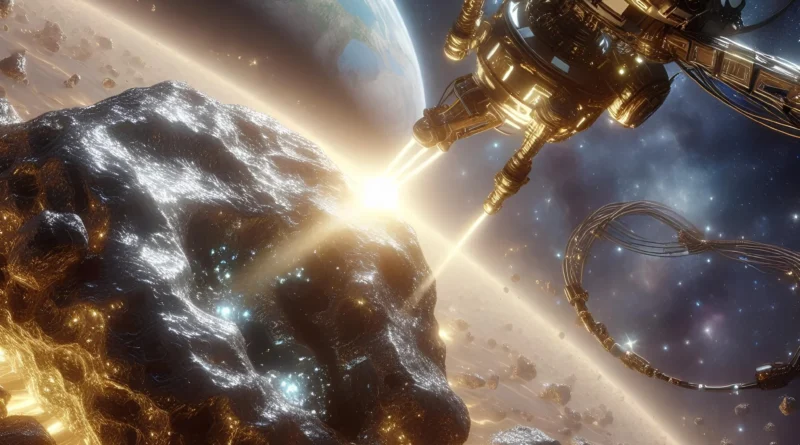Asteroid Mining: A Trillion-Dollar Opportunity for the Future
Table of Contents
Introduction to Asteroid Mining
Asteroid mining refers to the prospect of extracting valuable resources from asteroids, which are remnants from the early solar system. This innovative approach to resource acquisition has gained immense interest in recent years as terrestrial resources become increasingly scarce and the global demand for rare metals continues to rise. Elements such as platinum, gold, and other precious metals, which are essential for numerous industries, including electronics and renewable energy technologies, drive the pursuit of asteroid mining.
The concept of mining from asteroids is rooted in both practical necessity and the technological advancements that have made space exploration more feasible. With the proliferation of private space companies and advancements in spacecraft technology, the idea of landing on asteroids and harvesting them for materials is no longer relegated to the realm of science fiction. As research efforts continue to grow, the potential economic benefits of mining asteroids could represent a paradigm shift in how industries secure the necessary materials for production.
The motivation for asteroid mining stems not only from the desire for valuable resources but also from the sustainability aspect. The increasing depletion of Earth’s mineral resources poses challenges for future generations, prompting a search for alternative sources. Asteroids are estimated to harbor an abundance of metals, with some containing quantities vastly surpassing those available on Earth. Moreover, asteroids may serve as platforms for scientific research, enabling deeper understanding of the solar system and potentially offering the means to support future space colonization efforts.
As we delve deeper into this topic, it becomes evident that asteroid mining presents a significant opportunity for innovation and economic development. Its rise as a compelling prospect in today’s technological landscape underscores the culmination of scientific curiosity and the pressing need for new resource avenues. The ensuing discussions will explore the intricacies associated with the venture into asteroid exploration and the far-reaching implications it holds for humanity.
The Valuable Targets: Rare Metals and Their Importance
Asteroid mining presents a unique opportunity to access rare metals that are becoming increasingly crucial in various industries. Among these metals, platinum and gold stand out due to their exceptional properties and applications. Platinum, for instance, is a key component in catalytic converters, which play a vital role in reducing harmful emissions from vehicles. Additionally, it is used in electronics and renewable energy technologies, such as hydrogen fuel cells, illustrating its importance in the transition towards sustainable energy solutions.
Gold, on the other hand, is not only valued for its aesthetic appeal but also for its significant role in the electronics industry. It is an excellent conductor of electricity and resistant to tarnish, making it ideal for electronic components and connectors. The demand for gold continues to rise alongside advancements in technology, particularly with the increasing proliferation of smart devices and renewable energy systems.
Other rare materials targeted in asteroid mining include iridium, rhodium, and various rare earth elements. Iridium, known for its corrosion resistance and high melting point, is essential in manufacturing spark plugs and various electrical components. Rhodium is critical for catalytic converters, further emphasizing the importance of these metals in reducing vehicle emissions and supporting environmental sustainability.
The scarcity of these metals on Earth adds urgency to the exploration of alternative sources. Traditional mining practices pose significant environmental concerns, and the depletion of terrestrial resources drives the search for solutions beyond our planet. The potential of asteroid mining lies not only in the abundance of these valuable targets in space but also in the prospect of meeting industrial demands without exacerbating the ecological footprint associated with terrestrial mining activities. As the global economy transitions towards greener technologies, the availability of rare metals from asteroids could play a pivotal role in ensuring sustainable progress.
Challenges and Innovations in Asteroid Mining
Asteroid mining presents a myriad of challenges that must be addressed in order to realize its potential as a viable industry. One of the foremost obstacles is the technological complexities involved in both resource extraction and transportation. To extract materials from asteroids, sophisticated robotic systems must be developed that can operate in the harsh environment of space. These machines need to be capable of performing delicate tasks such as drilling, processing, and collecting resources while ensuring minimal disruption to the asteroid’s structure.
The costs associated with asteroid mining are another significant challenge. Current estimates indicate that launching missions to asteroids may require billions of dollars, rendering such endeavors economically prohibitive without a clear framework for return on investment. The technology to deliver payloads back to Earth similarly needs advancement, as transporting mined resources must be both efficient and cost-effective. Effective propulsion systems and re-entry technologies have to be developed to ensure that materials can be safely delivered to the planet’s surface.
However, the field of asteroid mining is also seeing remarkable innovations. Recent developments in spacecraft technology and robotics have opened new avenues for exploration and extraction. Notable missions, such as NASA’s OSIRIS-REx and Japan’s Hayabusa2, have successfully demonstrated the capability of robotic spacecraft to land on and collect material from asteroids. These successes provide valuable insights for future endeavors and help build the technology needed for larger-scale operations.
Moreover, advancements in artificial intelligence and machine learning are paving the way for more autonomous robotic missions that can operate with minimal human intervention. As these technologies evolve, so too does the potential for asteroid mining to transition from theoretical concepts to practical applications. By overcoming existing challenges and leveraging innovative solutions, the asteroid mining industry holds promise for unlocking a wealth of resources in space.
Economic Impact and Future Prospects
The prospect of asteroid mining presents a transformative opportunity for the global economy, potentially leading to the generation of vast wealth as conventional resources become scarce. Experts predict that successful extraction of metals and minerals from asteroids could result in a new economic landscape, effectively reshaping markets and creating unprecedented financial prospects. Asteroids are rich in valuable resources, including platinum, nickel, and rare earth metals, which are essential for advanced technologies and clean energy solutions. As demand for these materials grows, the ability to harness them from space could alleviate supply issues on Earth.
According to industry forecasts, asteroid mining could yield trillions of dollars in resources over the next few decades. This wealth generation may lead to the emergence of new economic players, including potential trillionaires, as innovative companies tap into the asteroid belt. The advent of space mining could foster advancements in technology, engineering, and logistics, driving investment in aerospace industries and creating lucrative jobs that did not exist in previous generations.
Moreover, asteroid mining would likely promote competition among nations and corporations, spurring not only economic growth but innovation. The acquisition of extraterrestrial resources could destabilize traditional pricing structures, leading to fluctuating market dynamics that could significantly affect global economies. This would require governments and regulatory frameworks to adapt swiftly, addressing challenges related to ownership rights and environmental considerations associated with space exploitation.
As the use of space resources becomes more feasible, investment in such initiatives may attract diverse financial stakeholders, including private investors, venture capitalists, and governmental bodies. By diversifying the ways in which resources are sourced, asteroid mining could also play a crucial role in sustainable development efforts, ensuring that future generations have access to essential materials while alleviating the environmental impact of terrestrial mining. In conclusion, the potential economic implications of asteroid mining are vast, holding the promise of revitalizing industries, creating wealth, and fostering a new era of exploration and innovation.

